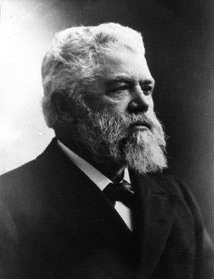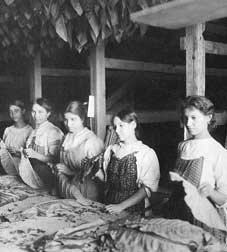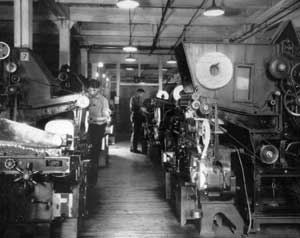INDUSTRIAL HAMILTON: A TRAIL TO THE
FUTURE
The Tuckett Tobacco Company Limited
Location: Queen Street North, between York Street and Barton
Street, Hamilton, Ontario
 George
Elias Tuckett founded his first of several tobacco businesses in 1857 at the
age of 22. Although he originally came from Hamilton, he established his three-man
cigar making company in London, Ontario. Unfortunately, this business did not
last long. The following year, George E. Tuckett moved back to Hamilton and
opened another cigar making business at the southeast corner of York and Bay.
It was said that his wife would sell the cigars he made at the market a few
blocks away.
George
Elias Tuckett founded his first of several tobacco businesses in 1857 at the
age of 22. Although he originally came from Hamilton, he established his three-man
cigar making company in London, Ontario. Unfortunately, this business did not
last long. The following year, George E. Tuckett moved back to Hamilton and
opened another cigar making business at the southeast corner of York and Bay.
It was said that his wife would sell the cigars he made at the market a few
blocks away.
Eager to expand his trade, Tuckett formed a partnership with Alfred Campbell
Quimby in 1862. Their new firm was called Quimby and Tuckett and they made plug
tobacco (a type of chewing tobacco) to supply Quimby's tobacco store. Since
almost all of the tobacco that Tuckett and Quimby used came from Virginia, they
encountered a shortage of tobacco as the American Civil War (which began in
1861) progressed. Tuckett and Quimby were compelled to cross the border and
buy tobacco from behind Confederate lines. They would store this tobacco in
warehouses and proceed to bring it back to Canada once the battle lines had
passed them by. Due to the strain of importing tobacco and running the factory,
Tuckett left the tobacco business, along with the city, to try and restore his
health in 1864. The Quimby and Tuckett partnership was over but there were still
new prospects for Tuckett to pursue.
No sooner had Tuckett returned to Hamilton in late 1864 then he was elected
councilor for the St. Mary's Ward. Nevertheless, Tuckett still had a family
to support and in 1865 he helped to form the Hamilton Glass Works with John
Billings and a few other men. Although the glass business was a change for Tuckett,
it was one that he did not welcome. It is rumored that one day he simply got
sick of selling glass and proceeded to throw his samples into the lake.
 1866
marked a return to the tobacco business for Tuckett. The establishment of Tuckett
and Billings meant a renewed partnership with John Billings. With 70 employees
and a daily capacity of 1,000 lbs., this was the biggest venture yet for Tuckett.
In 1880 Billings retired and went on to become the chairman of the Hamilton
Hospital Board. Tuckett renamed the firm George E. Tuckett & Son and employed
his son (George T. Tuckett) and his nephew (John E. Tuckett) to help him. George
E. Tuckett's fourth foray in the tobacco industry was his most successful yet.
Business expanded so much that in 1890 a five-story factory was built on Queen
Street to help cope with demand. The first product of the new factory was Myrtle
Navy cut plug tobacco.
1866
marked a return to the tobacco business for Tuckett. The establishment of Tuckett
and Billings meant a renewed partnership with John Billings. With 70 employees
and a daily capacity of 1,000 lbs., this was the biggest venture yet for Tuckett.
In 1880 Billings retired and went on to become the chairman of the Hamilton
Hospital Board. Tuckett renamed the firm George E. Tuckett & Son and employed
his son (George T. Tuckett) and his nephew (John E. Tuckett) to help him. George
E. Tuckett's fourth foray in the tobacco industry was his most successful yet.
Business expanded so much that in 1890 a five-story factory was built on Queen
Street to help cope with demand. The first product of the new factory was Myrtle
Navy cut plug tobacco.
 In
1890, George E. Tuckett decided to retire partially from his stake in the tobacco
business and let his son take charge. The following year, George E. Tuckett
& Son introduced cigars into their product lineup. Employing 12 at its inception,
the cigar-making branch would grow to 200 in the following years. In 1892, the
business was incorporated as the George E. Tuckett & Son Company, Limited.
Also that year, the more expensive 10-cent Marguerite cigar was introduced.
Due to further growth, the cigar-making branch was moved back to their old buildings
on King Street West in 1893. In 1896 cigarettes were added to their product
lineup. Their first cigarette brand, called the T. & B. (presumably after
Tuckett's former partner), was a success. Its popularity even spread outside
of Canada to such places as: England, South Africa, Australia, and New Zealand.
The same year, George E. Tuckett's responsibilities increased when he ran and
was elected the 32nd mayor of Hamilton. In 1898, an addition to the plant for
handling and processing Canadian tobacco was constructed, raising employment
to 400.
In
1890, George E. Tuckett decided to retire partially from his stake in the tobacco
business and let his son take charge. The following year, George E. Tuckett
& Son introduced cigars into their product lineup. Employing 12 at its inception,
the cigar-making branch would grow to 200 in the following years. In 1892, the
business was incorporated as the George E. Tuckett & Son Company, Limited.
Also that year, the more expensive 10-cent Marguerite cigar was introduced.
Due to further growth, the cigar-making branch was moved back to their old buildings
on King Street West in 1893. In 1896 cigarettes were added to their product
lineup. Their first cigarette brand, called the T. & B. (presumably after
Tuckett's former partner), was a success. Its popularity even spread outside
of Canada to such places as: England, South Africa, Australia, and New Zealand.
The same year, George E. Tuckett's responsibilities increased when he ran and
was elected the 32nd mayor of Hamilton. In 1898, an addition to the plant for
handling and processing Canadian tobacco was constructed, raising employment
to 400.
 The
turn of the century marked the death of George E. Tuckett, the founder of the
oldest established tobacco manufacturing enterprise in Canada. George T. Tuckett
would become the company's president until his own death in 1913. 1900 also
marked the beginning of more expansions for the company. Cigar factories were
opened in London and Montreal and employment in Hamilton surpassed 1,000. During
the next decade, the company's cigarette division would expand as well. New
brands were introduced such as: Keno, Tuckett's Turkish Special, and Tuckett's
Preferred. In 1912 the company was incorporated yet again as the Tuckett Tobacco
Company Limited. It then went on to obtain control of the McAlpine Tobacco Company
of Toronto, acquiring several brands of cigarettes including: British Navy,
King's Navy, and Lucky Strike. Tuckett Tobacco's biggest period of expansion
would begin in 1923 with the purchase of Tobacco Products Corporation of Canada.
The following year production of Buckingham cigarettes commenced. These cigarettes
would grow in popularity to eventually hold 80% of the Canadian market for blended
cigarettes. 1930 marked an interesting turn of events, as the Tuckett Tobacco
Company was itself acquired by the Imperial Tobacco Company of Canada. Development
continued however, and in 1957 the company moved their offices to Main Street
and invested $2 million on modernization and expansion, adding $1,250,000 worth
of new machinery along with air-conditioning, fluorescent lighting, and a cafeteria.
The
turn of the century marked the death of George E. Tuckett, the founder of the
oldest established tobacco manufacturing enterprise in Canada. George T. Tuckett
would become the company's president until his own death in 1913. 1900 also
marked the beginning of more expansions for the company. Cigar factories were
opened in London and Montreal and employment in Hamilton surpassed 1,000. During
the next decade, the company's cigarette division would expand as well. New
brands were introduced such as: Keno, Tuckett's Turkish Special, and Tuckett's
Preferred. In 1912 the company was incorporated yet again as the Tuckett Tobacco
Company Limited. It then went on to obtain control of the McAlpine Tobacco Company
of Toronto, acquiring several brands of cigarettes including: British Navy,
King's Navy, and Lucky Strike. Tuckett Tobacco's biggest period of expansion
would begin in 1923 with the purchase of Tobacco Products Corporation of Canada.
The following year production of Buckingham cigarettes commenced. These cigarettes
would grow in popularity to eventually hold 80% of the Canadian market for blended
cigarettes. 1930 marked an interesting turn of events, as the Tuckett Tobacco
Company was itself acquired by the Imperial Tobacco Company of Canada. Development
continued however, and in 1957 the company moved their offices to Main Street
and invested $2 million on modernization and expansion, adding $1,250,000 worth
of new machinery along with air-conditioning, fluorescent lighting, and a cafeteria.
All these renovations were in vain however. In 1964, Imperial Tobacco decided
to move its Hamilton manufacturing operations to its new facility in Guelph,
effectively ending the Tuckett tobacco tradition in Hamilton.
Click here to view more Tuckett Tobacco images.
References:
- Gardiner Scrapbook v. 34. Special Collections, HPL.
- Head-of-the-Lake Historical Society. Wentworth Bygones No. 3.
- Torrance, Tom. "Looking Back: The Tuckett Tobacco Company Limited" Let's
Talk Business, vol.4, no. 2.
Links:
 George
Elias Tuckett founded his first of several tobacco businesses in 1857 at the
age of 22. Although he originally came from Hamilton, he established his three-man
cigar making company in London, Ontario. Unfortunately, this business did not
last long. The following year, George E. Tuckett moved back to Hamilton and
opened another cigar making business at the southeast corner of York and Bay.
It was said that his wife would sell the cigars he made at the market a few
blocks away.
George
Elias Tuckett founded his first of several tobacco businesses in 1857 at the
age of 22. Although he originally came from Hamilton, he established his three-man
cigar making company in London, Ontario. Unfortunately, this business did not
last long. The following year, George E. Tuckett moved back to Hamilton and
opened another cigar making business at the southeast corner of York and Bay.
It was said that his wife would sell the cigars he made at the market a few
blocks away. 1866
marked a return to the tobacco business for Tuckett. The establishment of Tuckett
and Billings meant a renewed partnership with John Billings. With 70 employees
and a daily capacity of 1,000 lbs., this was the biggest venture yet for Tuckett.
In 1880 Billings retired and went on to become the chairman of the Hamilton
Hospital Board. Tuckett renamed the firm George E. Tuckett & Son and employed
his son (George T. Tuckett) and his nephew (John E. Tuckett) to help him. George
E. Tuckett's fourth foray in the tobacco industry was his most successful yet.
Business expanded so much that in 1890 a five-story factory was built on Queen
Street to help cope with demand. The first product of the new factory was Myrtle
Navy cut plug tobacco.
1866
marked a return to the tobacco business for Tuckett. The establishment of Tuckett
and Billings meant a renewed partnership with John Billings. With 70 employees
and a daily capacity of 1,000 lbs., this was the biggest venture yet for Tuckett.
In 1880 Billings retired and went on to become the chairman of the Hamilton
Hospital Board. Tuckett renamed the firm George E. Tuckett & Son and employed
his son (George T. Tuckett) and his nephew (John E. Tuckett) to help him. George
E. Tuckett's fourth foray in the tobacco industry was his most successful yet.
Business expanded so much that in 1890 a five-story factory was built on Queen
Street to help cope with demand. The first product of the new factory was Myrtle
Navy cut plug tobacco.
